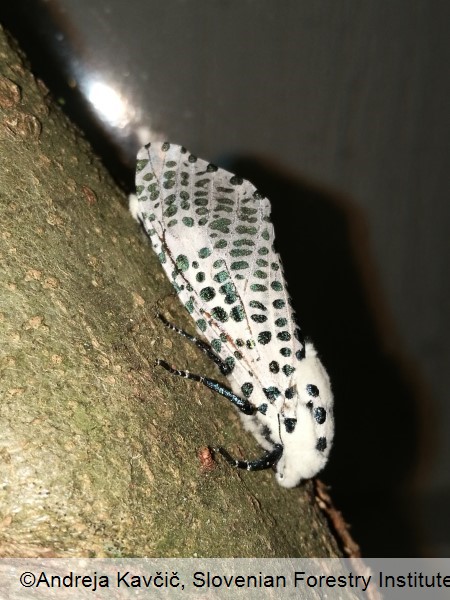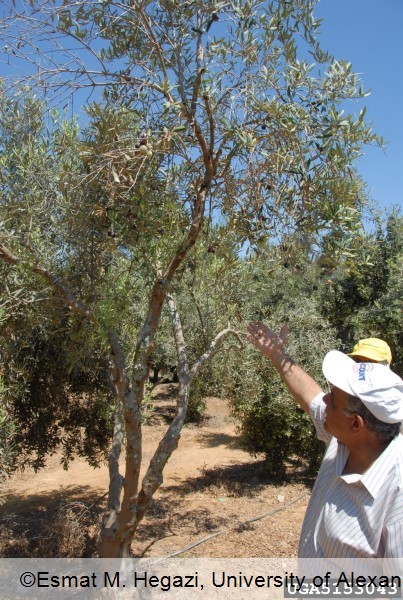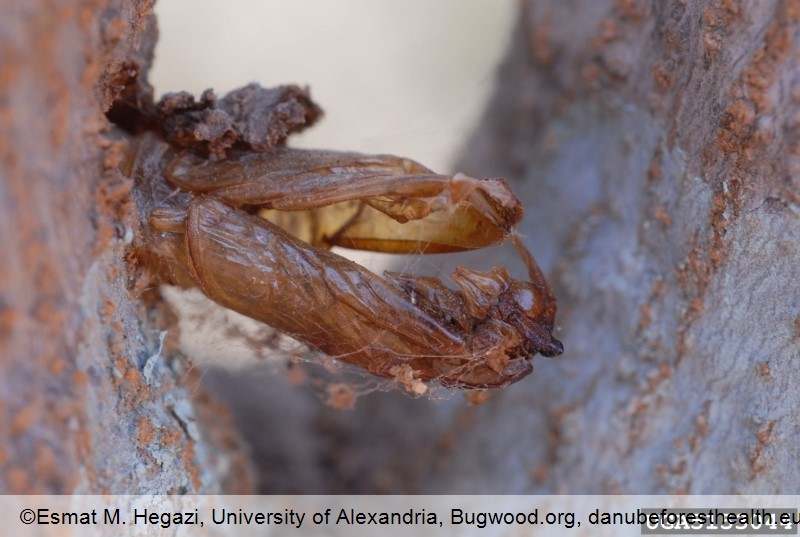Animalia
Leopard moth
Zeuzera pyrina
Andreja Kavčič
|
|

Fig. 1. A Zeuzera pyrina adult

Fig. 2. A caterpillar

Fig. 3. Damage caused by the leopard moth larva

Fig. 4. Exuviae left in the emergence hole after the moth has left the host
DETECTION PERIOD:
May to September, larvae can be found in wood all year round
DESCRIPTION:
Adults are white moths, their wings and body studded with irregular black-blue dots. Legs are black-blue. Males are 20 mm long, with the wingspan of 35–40 mm. Females are larger, 25–30 mm long, with the wingspan of 50–60 mm. The development takes place in the wood of host plants and lasts from two to three years. Moths fly from May to September. After mating females lay eggs on buds, leaves or twigs. Newly hatched larvae bore into twigs, causing withering of leaves. As the larvae develop, they bore into thicker parts of the host, where they continue feeding on heartwood. The leopard moth larvae can be found mainly on young trees, living in thin trunks and branches. Larvae are yellow, dotted with black tubercles along the body, the head is black. They grow 50–55 mm in length. By the end of their development, larvae gnaw tunnels in wood that can be up to 40 cm long. Larvae overwinter. The pupation occurs at the end of the larval tunnel from April to July.
HABITAT:
The leopard moth can be found in natural habitats, nurseries, plantations and urban areas. Larvae are polyphagous, they feed on a variety of hardwood trees and shrubs. They are frequently found on fruit trees (Malus spp., Pyrus spp., Prunus spp., …), but also on other broadleaved species (Fraxinus spp., Betula spp., Acer spp., Quercus spp., Sorbus spp., Salix spp., Fagus spp., …). Zeuzera pyrina prefers hosts in southern and warmer localities.
STATUS:
Zeuzera pyrina is widespread in Europe, but it can be found also in northern Africa and in Asia. It has been introduced into the northern USA.
IMPACT:
Damage is caused by larvae, which develop inside the host and feed on wood. Attacked parts wilt and die off. Hosts lose their vigor and defense ability and are further damaged by other pests and diseases. The leopard moth causes serious damage in orchards and fruit tree plantations, especially in the Mediterranean region. It can be harmful also in forests. Outbreaks are not common as the leopard moth mainly attacks individual trees.
SIMILAR SPECIES:
Symptoms and signs resemble those of other wood boring insects, such as the goat moth, Cossus cossus. However, Zeuzera pyrina adults and larvae can be easily distinguished from other species.
|